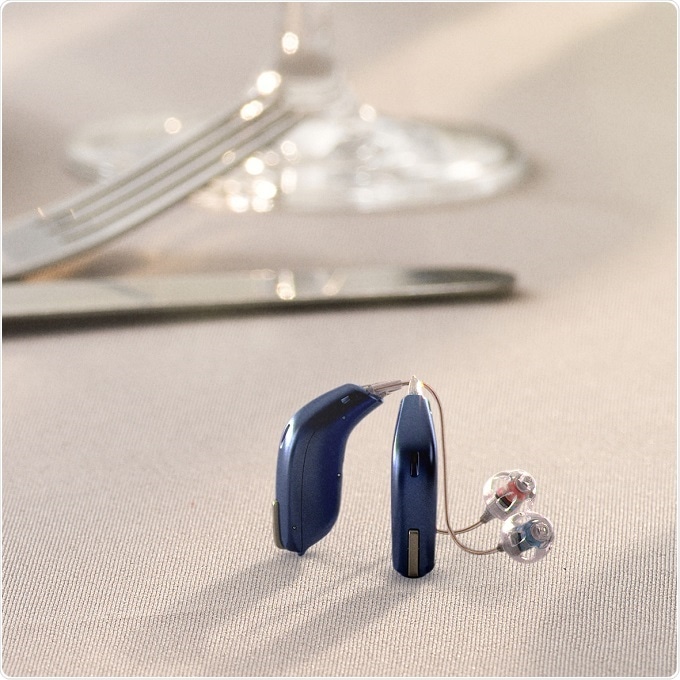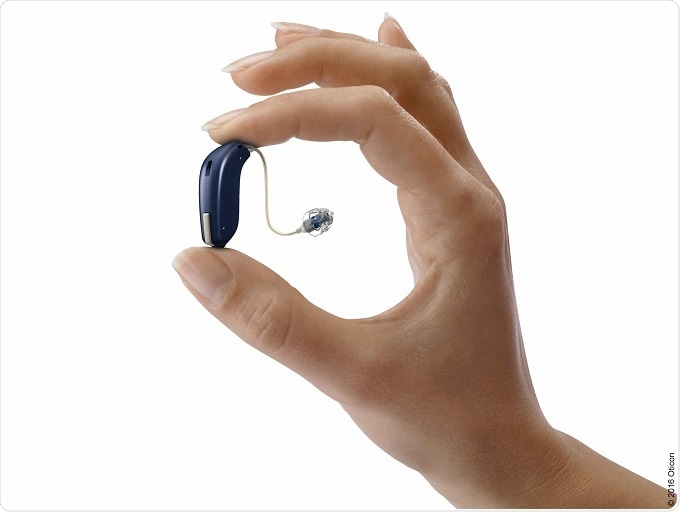Oticon Opn is a hearing aid that allows connection to a smartphone and supports all the internet-enabled connectivity that you have on the internet that smart devices support.
We have specifically chosen a web-based community called “If This Then That” (IFTTT) because it is a relatively very easy to use third party service that is supported by a lot of the large global device manufacturers, such as Philips and others, that provide home appliances and convenience electronics to help people in their daily routines.
What impact do you hope Opn will have for people with hearing impairments?
We have a lot of evidence on what Opn is doing for people, so we don't only have to hope, we actually already know a lot about what it can do.
We've conducted five scientific studies on the device so far and we know that, first and foremost, Opn can do what the best hearing aids can do today, which is to improve on people's ability to understand speech in noise.
Also, with Opn, we've introduced new benefits to hearing care that haven't been seen before. Using objective measures, we have documented that Opn is reducing the load on the brain that a person with hearing loss typically experiences when they listen to speech in noise. We directly make it less demanding for the brain to make sense of the sounds that people are listening to.
We confirmed this by conducting a study whereby we looked at whether this facilitates what we call cognitive benefits. “Cognitive benefits” is something that enables the brain to do something else because cognitive capacity or brain power has basically been freed up to make decisions or to do something that you could not do before.
What we chose to look at was people's ability to remember. In a study, we've documented that people can remember up to 25% better with our Opn hearing aid when we activate the noise reduction technology that makes surrounding noise less intrusive.

Oticon Opn
What feedback have you received from users so far?
We've received the best feedback we've ever had for a new hearing aid introduction.
People are describing to us how they are now able to do things that they could not do before. For instance, some people are saying "In the past, I was really challenged when I went to the restaurant with my friends. Now I can go there; I can feel relaxed and I can sit wherever I want in the restaurant."
Typically, many hearing aid users find a quiet corner of the café or restaurant with their backs to a wall, so they wouldn't be too impacted by noise from behind them. It's things like this that they are now more freed up from.
There is a lawyer who has been using Opn. In the past, not only did he struggle to hear what people were saying in the courtroom, but he needed an assistant to inform him once in a while if there was something that he had missed out on. With Opn, he can now follow everything that happens in the courtroom and he can even judge the mood of the judge because he now has Opn handling the surroundings and especially reducing the noise much more than it was possible to in the past. That frees up cognitive capacity for him.
We know that doing something like judging the mood of somebody is particularly challenging and requires that the brain is not too loaded; it needs to have residual capacity. Typically, when you decode the meaning of a sound, first you decode the direct meaning of whatever is said, the meaning of the word, and then after that, you can decode the deeper meaning such as the mood of the person or some hidden message in what was said and so on.
That all requires extra cognitive capacity. Hearing loss removes cognitive capacity from people, which is what many people don't realize about hearing loss. It is not only the loss of the ability to hear soft sounds, it's also that the brain is struggling so much more, that it's recruiting resources from parts of the brain that would normally be used on something else and that has an impact on your general function and your ability to function well, especially in social situations.
Oticon Opn™ miniRITE - Open up your world
How important was the size and design in the development of Opn?
That is always very important to us. That's why we chose the most preferred size and design as the hearing aid style that was first introduced. However, compared to all these benefits I just talked about, we did prioritize getting the new noise reduction systems in place and getting the new connectivity in place that is enabling the new IFTTT service.
In addition to enabling you to connect to the internet, this new connectivity also allows you to connect directly to an iPhone and use the iPhone as a smart remote for the hearing aid. It is that kind of connectivity that is removing barriers for people with hearing impairment.
I've been talking a lot about how we've achieved some new, unseen benefits with Opn that people haven't had before. That is the important step forward from a medical device perspective, we are improving on the quality of the healthcare we are delivering.
Alongside that, we also want to make it easier for people with hearing impairment to live their lives and to pick up whatever they would like to do, for instance, with social media and all the development in the media landscape that we currently see.
That's why we also chose to include the IFTTT service, because it builds in a number of new ease-of-use aspects. That then helps to lower the barriers of connecting to people, friends and family for people with hearing loss.
For example, it allows them to hear the doorbell. In the past, people needed special solutions for their homes if they were going to be able to hear the doorbell while they were at the other end of the house. Now, if you have this IFTTT-enabled doorbell, the doorbell will automatically send a signal to the hearing aid if the smart phone is in range. People can also get direct notifications in their hearing aids, such as: that they have to remember a meeting or they have a coffee appointment with a friend and so on. All of which helps people stay socially active.
What were the main challenges when developing Opn?
As always, when you create new technologies that are removing barriers, this was a huge undertaking, getting all the basic technology ready and maturing it to a stable level before we launched the product.
Bluetooth technology uses a lot of energy to ensure a good stable connection, for instance, between your smartphone and your PC, or your smartphone and your headset or your smartphone and your car. The battery power that you have in hearing aids is relatively small compared to what you have in PCs or cars or smartphones, so we needed a new technology.
That technology is called ‘Bluetooth low energy’. We needed to make that technology work in our hearing aids and create a strong and stable connection to the hearing aid.
That was challenging because the Bluetooth technology is communicating on a 2.4 gigahertz frequency and that frequency is very susceptible to obstacles that include water – this means that your body or your head could become an obstacle as we have a lot of water in our body We had a lot of technical challenges making this work and at the same time not using too much power in the hearing aid. That was one of the basic technological challenges that we had with Opn.
In addition to that, we also had to stabilize and optimize the performance of the noise reduction system. We call it the OpenSound navigator because it allows people to open up to their environments, to hear all the sounds around them and to focus on what they want. That is a very fundamental aspect of the way the brain is working but that function is often removed or not fully working at its best for people with untreated hearing loss. Enabling people to focus on what they want by staying open to all the sounds around them was something that was very important to us.
In the past, to get rid of disturbing noises, hearing aids had to somehow create an artificial focus on what was in front of a person and also suppress everything else around the person. That meant that a lot of the time, people wouldn't be able to pick up on those surrounding sounds.
If, for instance, somebody mentions your name in a noisy environment and that person is not in front of you, it would be very hard for you to hear this. With Opn, that becomes much easier because we basically open up to all sounds and we only remove the noises that don't carry any meaning.
There are a number of detectors in the hearing instrument that are constantly evaluating whether the sound from a given direction is speech or noise, if it has meaning or not, what level it is at and what frequency it is at.
We use that to sort the sound that we get into the hearing aid. We do that and evaluate the analysis of the environment 500 times per second and then decide how to change the processing in the device to optimally support the hearing aid use.
Was that the reason for the name Opn?
Yes. We are able to ‘open up’. Not only can we directly open up to sounds around a person but we can also empower them. By lowering the cognitive load, we empower them to open up to better embrace social interaction.

Oticon Opn
Oticon has recently won a prestigious Red Dot design award for Oticon Opn, what impact will this have?
This is certainly a very nice award for us to win. We haven't won it in a while but we did win it about 10 years ago for another very innovative design for a hearing aid.
It’s very important to us that independent bodies recognize our innovation and especially that we get this recognition for something related to improved health care.
Last time we got recognized for a new mechanical design. This time we are getting recognized for a design that is facilitating the lives of people with hearing impairments.
It is really important to us that people can see that we are working hard to make it easier for people with hearing impairment to live life as they would like to live it.
How much does Opn differ from other smart hearing aids on the market?
We have a number of features in the device that are very unique to Oticon Opn. The first one being the OpenSound navigator system which allows people to open up to the world in a whole different way whilst removing the disturbing noise so that they can handle the complexity of social interaction which typically takes place in environments that are quite noisy.
We also offer IFTTT connectivity based on what we call dual radio technology that enables the hearing aids to stay connected to the internet while also allowing them to communicate with each other so that the two hearing aids on each side of the head are always exchanging information to optimize the performance of the device.
That last bit is something that is well known, but the combination of all of this is quite unique and still one year after we launched it, Opn is the only device that has the IFTTT functionality. It is also the only device to have this advanced noise reduction system reducing the load on the brain and at the same time improving people's ability to remember.
What do you think the future holds for smart hearing aids?
We have some very ambitious goals for smart hearing aids. One of the things we're looking at in the longer term is putting something like EEG into hearing aids so the devices can perform advanced monitoring of the brain, in real time. Based on what is happening in the brain, we can then decide how to optimally support the user.
For instance, if we can see from the EEG analysis that people are very loaded and are getting tired from the current listening condition, then we can crank up the amount of support that we are providing to the user.
There are also a number of ideas for how you can use EEG to improve on hearing aid functionality. From the EEG, you can detect where people are looking and you can use that to optimize the sound to what people are looking at.
There are other signs. For instance, you can detect from the EEG whether people are napping or not. If they are napping, you may want to turn down the amplification. You wouldn’t turn it down too much, but just enough for them to hear if something happens so they can still react if necessary, whilst not being disturbed by the smallest sound in the environment. There are many things we can do in the future.
We could also embed in the hearing aid some of these wearable functionalities and see whether people are running, walking, lying down or standing up. We can detect heart rate and a lot of different aspects of the person’s health. For us, it's only about deciding what we consider are the important aspects of hearing healthcare that we really want to prioritize and get done as quickly as possible.
I'm not saying this is easy. We can see that there are technological challenges in embedding all of these technologies in a very small mechanical design and making it all run on a very limited power source such as a small battery in the hearing aid. However, that doesn't hold us back from having these ambitions about making it even easier for people with hearing impairment to live their life.
We want people to put on their hearing aids in the morning and then not think about them any more until they take them off in the evening and put them to charge for the next day of use.
Please can you explain ‘Brain Hearing’?
What the brain is doing all the time is much more than just the sensation of sound. A good sense of hearing is empowering the brain to stay socially connected. That social connection is the reward that motivates people to engage and once they do that, they stimulate their brain in the best way possible to age well.
That is basically how we want to develop hearing technologies; to not only look at hearing as an isolated sense but to look at how it empowers the user to do what they want. As I said, we have documented that Opn does improve people's ability to hear speech in noise, but it also lowers the load on the brain and enables them to remember more.
That shows how we're thinking much more broadly about hearing rehabilitation and what a well-fitting hearing aid can do for people with a hearing impairment.
What is Oticon’s vision?
We want to help people live their life with the hearing aid that they have. When we say that, we really mean it in every aspect. It's all about empowering them to do what they want because people with untreated hearing loss have a tendency to withdraw and become socially isolated.
Social isolation is very well documented in accelerating a number of very serious health problems such as depression and dependency, with people not being able to live in their own home as long as they usually would.
It can even accelerate something as serious as dementia. We think it is very important that if people have significant hearing loss, they get it treated. Of course we would say that as a hearing aid manufacturer, but we have had numerous discussions with independent researchers about this and they all agree that the side effects of hearing aids are so small that there's no reason to not use a hearing aid if you have a significant hearing loss because the potential benefits are huge, although they are not really acknowledged broadly in society today.
Where can readers find more information?
About Thomas Behrens
 Thomas Behrens is the Head of Audiology and Director for the Centre for Applied Audiology Research at Oticon global headquarters in Denmark. He is responsible for clinical research, professional communication and definition of the audiology in new products for Oticon.
Thomas Behrens is the Head of Audiology and Director for the Centre for Applied Audiology Research at Oticon global headquarters in Denmark. He is responsible for clinical research, professional communication and definition of the audiology in new products for Oticon.
The Centre is typically involved in 15 research projects globally on an ongoing basis. Prior to this Thomas spent 10 years as Researcher and Project Manager at the Oticon Research Centre, Eriksholm.
Thomas areas of expertise in particular are spatial hearing, signal processing for hearing aids, technical audiology, outcome measures and methods for laboratory as well as field trials. Thomas has a master degree in Applied Signal Processing and a bachelor degree in Business Administration.